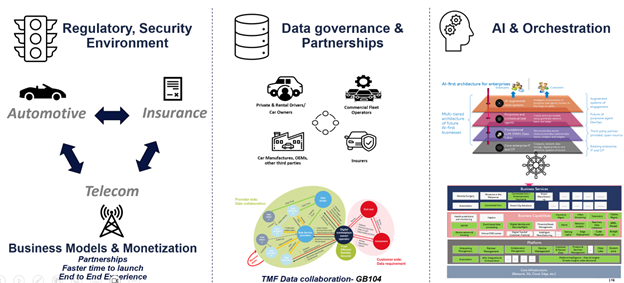Member Insights
Realizing Digital Ecosystem Platforms for CSPs – from strategy to value realization

Realizing Digital Ecosystem Platforms for CSPs – from strategy to value realization
The industry landscape is evolving towards greater customer ownership, a deeper understanding of market dynamics, and an enriched customer experience. Automotive and Insurance sectors serve as prime examples of this trend, as they establish collaborations to capitalize on the connected car ecosystem.
Partnerships are being formed to share customer-consented connected car data with insurance companies, enabling them to analyze driver behavior and risk patterns. This collaboration allows for the analysis of driver behavior and risk patterns, which can play a crucial role in underwriting and risk assessment processes associated with product management.
With the global connected car market projected to grow at CAGR of 18.4%, investments in autonomous vehicles are becoming a tangible reality. Cross-industry partners are concentrating on significant investments in Software Defined Cars, in-car experiences, safety, privacy, compliance, and the utilization of generative AI and data. Additionally, telcos are establishing alliances with major automotive brands for telematics initiatives. It is essential for Telcos to broaden their attention beyond telematics in order to fully capitalize on the opportunities offered by a value proposition that involves multiple partners and diverse offerings.

While the potential of these opportunities is huge, what makes the practical realization of these multi-party multi-industry opportunities so complicated? There are set of challenges for telcos towards monetizing such opportunities:
- Business model- requires building unique joint value creation, understanding target customers, bringing right capabilities for product-market fit as well evaluating reuse vs build approach.
- Value creation needs to follow with value capture, which spotlights the importance of consistent revenue realization
- How do telcos onboard right partners and carve out speedy joint value proposition for the market.
Following the resolution of these challenges, there is still one more decision to consider: what position do telcos intend to adopt?
As the connected car ecosystem develops, telcos have the opportunity to either maintain their focus solely on connectivity demand or to pursue a second option that emphasizes becoming a platform orchestrator. This could unlock new revenue streams through data orchestration, collaborative offerings, and innovative business models. Additionally, leveraging artificial intelligence could enhance demand by utilizing the data generated on the platform.
TM Forum’s Open Digital Architecture can be a key enabler for platform led growth through Concept to Design framework.

The Ecosystem Concept to Design framework effectively addresses the complexities outlined in the example by mitigating risks and expediting the curation and development of value propositions, partnerships, and platform businesses.

- Business value plans identify market opportunities, required co-creation capabilities and onboarding value measurement models. The interaction of value networks models across the key players in the connected car ecosystem and the roles telcos could play in monetization
- Value streams facilitate delivery mapping capabilities, emphasizing reusability and encompass end-to-end functionalities. Process involves recognizing elements that can be repurposed from the current architecture or from partners, determining what must be newly constructed, and identifying aspects that require enhancement or modification.
Let us look at readiness and reuse:

Development to launch of the Connected Car Insurance platform along with the associated products and service offerings Value Stream: Development to Launch of the Connected Car Insurance platform spans stages of Platform Strategy and Architecture definition, Product/Service/Information curation, Development, Pilot and Launch of the platform

- Capabilities indicated in purple signify the new requirements essential for the Platform Strategy, including the development and launch of the Connected Car Insurance platform, in contrast to traditional telecommunications-led platforms and associated partner products and services. This approach necessitates a multi-partner strategy and value curation, which will demand distinctive strategic choices regarding processes and partnerships. Furthermore, it requires a shift in mindset from operational bundling to business orchestration, as telecommunications companies aim to become the comprehensive custodians of the customer experience throughout the platform. From a TM Forum ODA capability perspective, party management ODA API which are comprehensively defined can be used to curate focused on multi-party platform management.
- Reusable capabilities – There are certain set of capabilities in telcos such as Product and Service Lifecycle mgmt. + Product/Service test management which could be reused for this use case.
- Some/major enhancements and contextualization to existing Telco’s capabilities – this is applicable for managing the platform operations in a new cross market text including Platform Governance, Platform Architecture management etc.

As the industry enhances its capabilities and progresses to the next phase of AI-driven orchestration, we anticipate further innovations in business models and technical advancements related to connected car offerings. It is essential to prioritize market regulations, security, and privacy concerns while monetizing data through this platform. Additionally, attention must be given to data governance and sovereignty, as well as the assessment of AI-based capabilities for improving features, intelligence, and the orchestration of the data environment.


